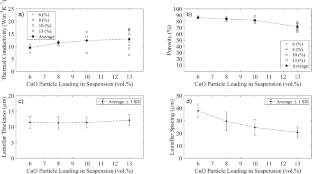用氧化铜悬浮液冷冻铸造具有片层状形貌的多孔铜以提高通面导热性
摘要
本研究报告了用冷冻铸造方法生产的具有片层形貌的多孔铜,其中氧化铜颗粒的水悬浮液(1µm - 2µm)在控制的冷却速率下冷冻,然后进行冰升华,还原成铜,烧结。研究了冷却速率(0.008 ~ 0.08°C·s−1)、颗粒加载量(6.0 vol . s−1)的影响%–13.0 vol %), and the concentration of polyvinyl alcohol (PVA) (1.2 wt %–3.6 wt %) on the through-plane effective thermal conductivity and structural characteristics of the as-produced material were investigated. Over a narrow range of cooling rates (0.016–0.026 °C·s−1), continuous lamellae formed, and the porous copper structures with 6.0 vol %–13.0 vol % particle loadings demonstrated an average porosity of 66.7–89.5 %, an average through-plane effective thermal conductivity of 9.5 \(\hbox {W m}^{-1}\cdot {K}^{-1}\)–12.9 \(\hbox {W m}^{-1}\cdot {K}^{-1}\), and average lamellar thickness and spacings less than 50 \(\upmu{m}\). The highest through-plane effective thermal conductivity of 16.7 Wm-1·K-1 was obtained at 65.7 % porosity with suspensions of 13.0 vol % particle loading. These results suggest that freeze-cast porous copper has a higher through-plane effective thermal conductivity than commercial copper foams for a given porosity. The fastest cooling rate (0.08 °C·s−1) resulted in engulfment of particle aggregates by the freezing front. The effective thermal conductivity along the freezing direction is not uniform, showing a less than 10.0 % difference in the samples produced with the cooling rate of 0.016 °C·s−1. Increasing the PVA concentration from 1.2 wt % to 3.6 wt % showed an insignificant influence on the non-uniformity of this property, but decreased its value due to the enlarged tilt angles.

This study reports porous copper with lamellar morphology produced with the freeze casting method, in which aqueous suspensions of cupric oxide particles (1 µm–2 µm) were frozen under controlled cooling rates, followed by ice sublimation, reduction to copper, and sintering. The effects of the cooling rate (0.008–0.08 °C·s−1), the particle loading (6.0 vol %–13.0 vol %), and the concentration of polyvinyl alcohol (PVA) (1.2 wt %–3.6 wt %) on the through-plane effective thermal conductivity and structural characteristics of the as-produced material were investigated. Over a narrow range of cooling rates (0.016–0.026 °C·s−1), continuous lamellae formed, and the porous copper structures with 6.0 vol %–13.0 vol % particle loadings demonstrated an average porosity of 66.7–89.5 %, an average through-plane effective thermal conductivity of 9.5 \(\hbox {W m}^{-1}\cdot {K}^{-1}\)–12.9 \(\hbox {W m}^{-1}\cdot {K}^{-1}\), and average lamellar thickness and spacings less than 50 \(\upmu{m}\). The highest through-plane effective thermal conductivity of 16.7 Wm-1·K-1 was obtained at 65.7 % porosity with suspensions of 13.0 vol % particle loading. These results suggest that freeze-cast porous copper has a higher through-plane effective thermal conductivity than commercial copper foams for a given porosity. The fastest cooling rate (0.08 °C·s−1) resulted in engulfment of particle aggregates by the freezing front. The effective thermal conductivity along the freezing direction is not uniform, showing a less than 10.0 % difference in the samples produced with the cooling rate of 0.016 °C·s−1. Increasing the PVA concentration from 1.2 wt % to 3.6 wt % showed an insignificant influence on the non-uniformity of this property, but decreased its value due to the enlarged tilt angles.

 求助内容:
求助内容: 应助结果提醒方式:
应助结果提醒方式:


